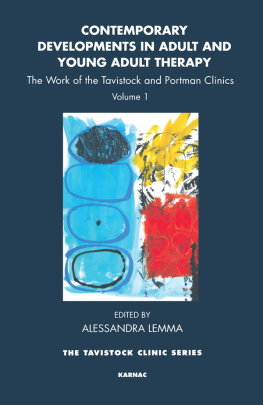All contributors retain the copyright to their own chapters.
The rights of the editor and contributors to be identified as the authors of this work have been asserted in accordance with 77 and 78 of the Copyright Design and Patents Act 1988.
All rights reserved. No part of this publication may be reproduced, stored in a retrieval system, or transmitted, in any form or by any means, electronic, mechanical, photocopying, recording, or otherwise, without the prior written permission of the publisher.
A C.I.P. for this book is available from the British Library
Margot Waddell
Since it was founded in 1920, the Tavistock Clinic has developed a wide range of developmental approaches to mental health which have been strongly influenced by the ideas of psychoanalysis. It has also adopted systemic family therapy as a theoretical model and a clinical approach to family problems. The Clinic is now the largest training institution in Britain for mental health, providing postgraduate and qualifying courses in social work, psychology, psychiatry, and child, adolescent, and adult psychotherapy, as well as in nursing and primary care. It trains about 1,700 students each year in over 60 courses.
The Clinics philosophy aims at promoting therapeutic methods in mental health. Its work is based on the clinical expertise that is also the basis of its consultancy and research activities. The aim of this Series is to make available to the reading public the clinical, theoretical, and research work that is most influential at the Tavistock Clinic. The Series sets out new approaches in the understanding and treatment of psychological disturbance in children, adolescents, and adults, both as individuals and in families.
In many ways, Contemporary Developments in Adult and Young Adult Therapy the first volume in what will surely become known as The Tavistock Trilogysucceeds in epitomizing aspects of the life and work of the two Clinics that comprise the Tavistock and Portman NHS Foundation Trust. Many of those who work here are often in two places at once: shouldering the ongoing challenges of the ever-changing clinical demands and requirements of peoples troubled and troubling lives and, simultaneously, managing, administrating, and researching on an ongoing day-to-day basis. Yet at the same time, these clinicians are on the move in different parts of the country and the worldlecturing, teaching, and training.
Implicitly, this volume goes some way towards addressing how all this can be possible. An answer, of sorts, is that for so long this work culture has recognizably characterized, and belonged to, a commitment to a world of solid values: those of loyalty, cooperation, esprit de corps , and purposea culture that has a generous, moral, and informed spirit. Yet now we have to respond to a new culture: the necessity to face the realities of the current political, economic, and cultural climatethe actuality of peoples everyday lives in the midst of NHS changes and the exigencies and impositions of wider social pressures.
Different ways simply have to be found, ways that Alessandra Lemmas impressive collection of contributors, chapters, and ideas lays out with vigour. As she says, one of the central areas of the overall Trust has always been the developmental continuity between childhood and adult mental difficulties. These will be further focused upon in the two subsequent volumes, where the emphasis will be on the depth of long-term psychoanalytic work and, differently, on the systemic model. One volume will address the complex dynamics between the internal and external worlds of children, adolescents, and their families; the other, the equally complex and related dynamic between the individual, the group, and institutional life. These subsequent two books will have their own style and emphasis, but I expect that among the many commonalities between all three will be a commitment to a pluralistic mental health context that can underpin the preservation of traditional principles. These volumes will look both ways: to the past as well as to the future. Indeed, such a perspective has been a familiar characteristic of the work of both Clinics since they were founded in the aftermath of the Great War. They were established in the face, respectively, of the fall-out from the casualties of war, shell-shock in particular, and of antisocial and delinquent behaviouramidst, in other words, the countless fractured lives, loves, and losses of the time. The ongoing extreme mental and emotional work that these pages describe has, even now, much to do with those early initiatives.
This book does justice to the lessons of history but is also decisively modernfor it describes, with great precision, some of the ways in which the joys and privileges of innovative research survive and thrive in our times. In the present economically pressurizing culture, the nature of the external demands on, and deprivations of, both young people and adults has properly to be seen in relation to the long-recognized vicissitudes of the developmental picture: that the process of growing up, with all its problems of separation and individuation, is, significantly, how it has always been.
But one of the clear strengths of the thinking and clinical practice represented here lies in just how impressive some of the innovations and adaptations of more traditional work can be. The much more textured understanding of and cooperative creative integration with other services will enable new forms of growth. The reader is introduced to a range of research carried out by staff determined to maintain the best standards of practice.
The detail of the work, in so many individual, group, and communityand even online-basedsettings, gives one hope that services will be able to expand and survive. Many of the chapters describe extremely testing situations, but they emphasize, above all, the importance of collaborative relationships. The book includes examples of both short- and long-term interventions, from forensic psychiatry to marital therapy and primary-care cooperation, as well as newly developing treatment models, from dynamic interpersonal therapy to the social media revolution. The engagement is with clinical need, on the one hand, and a cost-effective economy, on the other. One cannot but be impressed by the energy of writers who are struggling to keep internal and external worlds in relation to one anotherwhich is the very essence of the work of both Clinics.
Stephen Briggs has worked in the Adolescent Department at the Tavistock and Portman NHS Foundation Trust for 20 years and is currently the lead for the Psychodynamic Brief Therapy Service. He has written widely on adolescence, infancy, and suicide, including Working with Adolescents and Young Adults: A Contemporary Psychodynamic Perspective (2008), Growth and Risk in Infancy (1997), and Relating to Suicide and Self Harm: Psychoanalytic Perspectives on Practice, Theory and Prevention (2008, edited with Alessandra Lemma & William Crouch). He is Associate Dean, Specialist and Adult Mental Health Services, and Professor of Social Work and Director of the Centre for Social Work Research, Tavistock/University of East London.
Anca Carrington is a trainee psychotherapist in the Adult Department at the Tavistock Centre. She obtained her MA and PhD in economics, and, after nine years of university lecturing and research in this field, she joined the civil service, first as senior methodologist in spatial analysis at the Office for National Statistics, then as an economist at HM Treasury.









